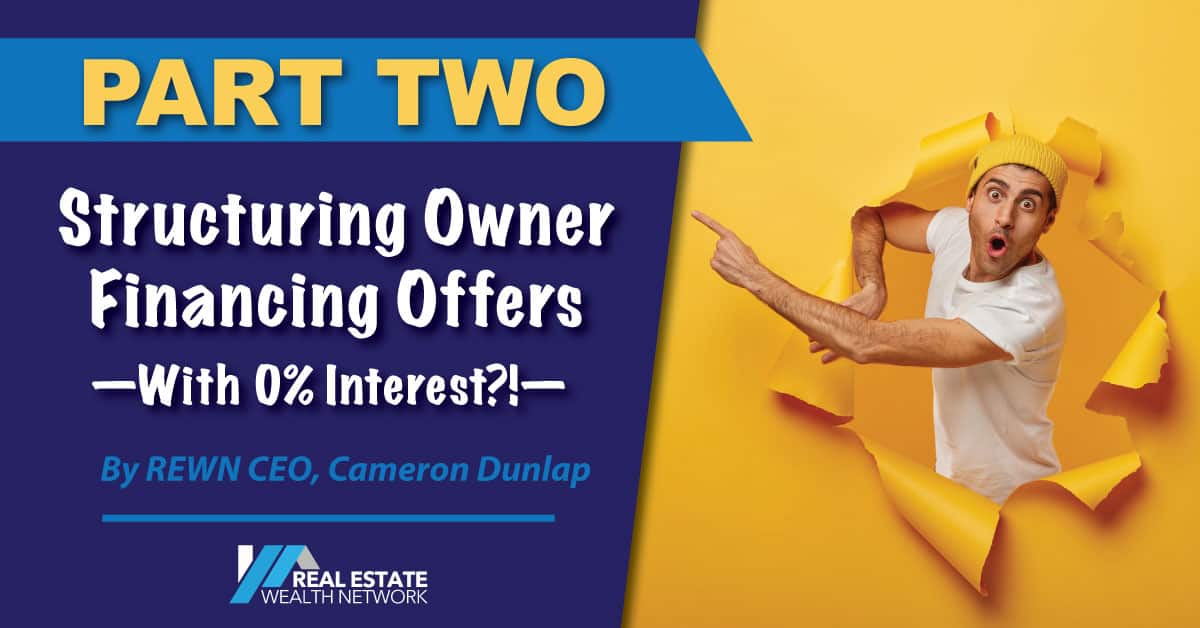
This is the second of a two-parter that deals with structuring owner financing offers..
Be sure to check out Part 1, because I shared the clear, compelling reasons why owner financing offers make such good sense and the importance of always going for a win-win or no deal.
Assuming you’ve already read that, let’s continue the conversation…
I’m answering a question from one of our Inner Circle students, who asked:
“Could you discuss the terms and the best way to structure an owner financing offer? I know these work best when the property is free and clear, but I’m a little unsure of how to determine the best terms.”
Since I covered the end of that question in Part 1, let’s dive into the beginning of that question…
How To Structure Owner Financing Deals
So, it is best if the seller owns the house free and clear. There’s no question about it. Because if there is an underlying mortgage, then that becomes a necessary part of the equation.
And to illustrate this, we’re going to keep the numbers super simple…
- We’re negotiating a $150,000 purchase.
- The mortgage balance is $100,000.
- The seller is willing to take payments on their equity, which in this case would be $50,000.
The presumption is the house is worth $150k to you, in whatever condition it’s in, because you’ve done your analysis and $150k is what you’re willing to pay.
The seller owes $100k. And they’re willing to take payments on their $50,000.
That means now you’ve got an underlying payment to the lender that you need to figure out: Is the seller going to continue to make it or are we going to make it on their behalf?
Comfortable With Subject To’s
Then, that’s like a subject-to-deal, where we receive the deed subject to the underlying mortgage — we don’t pay it off, we just take over the payments.
That generally requires the seller to be very motivated and very trusting of you to make those payments on a monthly basis… because their credit remains on the line — not yours, theirs.
So that requires the seller to be very comfortable with you, at the same time that they’re motivated enough to even consider that deal structure.
Wraparound Mortgages
Another way to do it would be in the form of a wraparound mortgage or what may be called an AITD — All-Inclusive Trust Deed. (It simply depends on the state as to what it’s called.)
The way a wraparound mortgage would work is you now have a mortgage with a value of $150,000 that you owe the seller. The deed is conveyed to you, and you’re making payments on that $150,000 mortgage… while the seller continues to make payments on a $100,000 mortgage, and they’re receiving the “arbitrage” on the $50,000 in equity that they are willing to take payments on.
It’s not particularly complex… most investor-friendly closing agents — whether it’s a title company or attorney — are going to be comfortable doing that sort of thing.
If you were to do a subject to, and the seller has $50,000 in equity, they grant the deed to you. The underlying first mortgage is not paid off… you begin making the payments on that and record a second mortgage on the property for $50,000 that is due and payable to the seller. And you make a separate payment on that.
Those two payments need to make sense. The numbers must work for you.
I need to mention that when the property is free and clear, there is no underlying mortgage. To make this a tad more complex you have the ability, if you choose, to negotiate a 0% interest mortgage.
It All Boils Down To “Win-Win”
So you might be wondering, how is that a win-win? If you’re paying zero interest, isn’t the seller losing?
Well no, not necessarily. Especially if you’re willing to pay at least a small premium for the property…
So, I might say I can pay the seller $150,000 cash, if my exit strategy is to wholesale it. Or, if the seller owns it free and clear, I could pay them $170,000 with seller financing, with payments of say, $1,100 until paid. (The payment amount depends on your exit strategy.)
And if the seller asks what does “payments of $1,100 until paid” mean? You just let them know that’s zero interest and the entire $1,100 gets applied to the principal.
And if they say they want to get interest, tell them that’s why you’re willing to offer them $170k. For $150k, you can do it with an interest rate, $170k is zero interest rate — which would they prefer?
You might find that some sellers would much rather see a higher sale price, because that’s where their bias is. Or they might be less interested in that and more interested in getting some specific return on the money that they’re effectively leaving in the house or that they’re effectively lending you.
No matter how you slice it, when you’re putting seller financing together, whether you’re the borrower or the lender, you are engaged in private lending. You’re either the borrower and the seller is a private lender, or you’re the private lender and your buyer is the borrower.
Either way, it’s private lending.
So, There You Go…
Hopefully you can now see how to make clear, compelling owner financing offers to certain sellers, why you should always structure them as a win-win for both parties on both sides of the table — or no deal, and the possibilities for structuring those kinds of offers.
Now all you have to do is go make some offers.
Regards,
Cam Dunlap